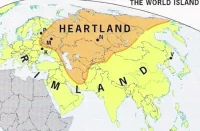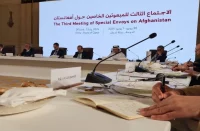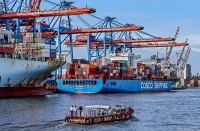Nikita Mendkovich (Russia)
Najibullah’s Kabul regime fell in 1992. Its defeat was a logical outcome of the termination of Russia’s material and technical support as US funding of the mujahedeen continued virtually unchanged even after Soviet forces withdrew. Unfortunately a new regime could not bring stability to the country: the commanders of the anti-Soviet troops that took Kabul were unprepared for the job of governing the country, nor were they willing to cooperate with each other. In the early 1990s, Afghanistan was marked by fighting between Pashtun (Hekmatyar) and Tajik (Massoud and Rabbani) warlords for control of the country, open fighting in the capital, and inflation driven by political instability and frequent currency releases by nominal political leaders to fund their own forces.
The inevitable result was the disintegration of the country into areas controlled by different forces whose commanders frequently did not even obey the leaders of their own political party. The new system of political power destroyed the existing trade links between cities and villages: the extortion exacted by a network of mujahedeen roadblocks covering the country rendered any domestic trade unprofitable. Industry came to a halt without deliveries of raw materials, and farmers lost their market for industrial crops.
One response of the population to the growing political and economic crisis was to become increasingly involved in illegal commerce, including the cultivation of opium poppies and the sale of opium.
The area of opium poppy cultivation and opium yields increased by 18% after the Najibullah regime fell. The following year, they increased by 22% and 46%, respectively. The crisis in the former Soviet Union greatly facilitated opium exporting. Because the unified border security and law enforcement systems collapsed and a severe economic crisis developed in Central Asia, the region previously closed to drug exports became a convenient channel for exporting opiates from northern Afghanistan to European markets. A “wild barter” system developed on the Afghan-Tajik border in the early 1990s, in which consumer goods (shoes, clothing, household appliances) from the CIS countries were exchanged for opium from Afghanistan. The situation was particularly acute in the Gorno-Badakhshan Autonomous Region (GBAO) of Tajikistan, which borders on Afghanistan. The region was subsidized during Soviet times: under the new economic conditions its population became brutally dependent on opium smuggling. Smuggled drugs from the GBAO were taken to Kyrgyzstan, and from there to the North.
An important competitive advantage of the newly opened northern smuggling route was its greater capabilities for processing opium into heroin, as compared to Iran and Pakistan. This “advantage” was due to the greater technical literacy of the post-Soviet population. Chemistry was a mandatory course in schools throughout the USSR, and it was not difficult to find a description of processes for producing morphine and diacetyl morphine (heroin) in the popular literature. As a result, the proportion of heroin in opiates confiscated in Central Asia amounted to at least 8%, while in Teheran it was less than 3%. Drug exports along the northern route understandably increased: according to the UN, in 1994 the proportion of heroin seized in the countries bordering on Afghanistan was 0.1%. It was 1% in 1996, 8.5%; in 1998; and 13% in 20001. Over time, the trafficking in Central Asia became more “professional”: wild bartering gave way to ordinary exchange of money. Division of labor took place; informal exchange markets developed; and standard routes for transporting opiates were established.
For a long time, the main barrier to drug dealers was the Russian border troops that were stationed in Tajikistan until 2004-2005. Russia was less affected by the post-Soviet crisis than Tajikistan, and that allowed it to maintain the fight against drugs in the region. Russian units controlled the border with Afghanistan that runs along the Pyanj River and a number of roads from Tajikistan to China and Kyrgyzstan. Local residents believe their methods were extremely brutal: Russian soldiers opened fire on everyone who violated the border zone without regard to gender or age. In controlling the highways, including the so-called “highway of life”—Khorog-Osh— autogenous cutting could be used to disassemble vehicles for inspection2. Admittedly, for all its brutality it appears that Russian oversight was much more effective than the methods currently employed by local law enforcement agencies. That is primarily due to the high level of corruption among officials in the new states. Arrests of high-ranking Tajik officials for personal involvement in transportation of Afghan heroin are eloquent testimony to the fact that the problem has existed for many years.
The situation on the Afghan opiates market underwent significant changes during the second half of the 1990s due to the new balance of power in national politics. As a reaction to the despotism of the warlords and the impotence of the traditional political parties that emerged during the struggle against the PDPA regime, the Afghan political scene witnessed the emergence of a new movement—the Taliban. This movement formed in the spring of 1994 out of Mullah Mohammed Omar’s volunteer force from Sangi Hissar. Mullah Omar said he supported reunification of the country and elimination of all illegal armed formations. That allowed him to form an alliance with the country’s nominal president, Rabbani, who initially supported the Taliban. On an equal basis with him, the movement was assisted by Pakistan’s intelligence establishment and a number of organizations from Arab countries. Military and political successes allowed Mullah Omar’s force to quickly transform itself into a broad-based organization. The backbone of its leadership was made up of former students of Pashtun madrassas in Pakistan (the Talibs). The Taliban were able to gain control over vast territories in the south of the country fairly quickly and partially restore law and order in them. A temporary decline in the area of opium poppy cultivation in 1995 is obviously related to that.
However, the Taliban were unable to retain their position as defenders of the rule of law. After formulating their claims to supreme authority and the collapse of the alliance with Rabbani, they had to fight a coalition of “old” warlords and face a more organized and sustained resistance. On the one hand, that led them to concentrate their forces in the combat zone and resulted in insufficient forces to maintain order in rear areas; on the other hand, the endless civil war was increasingly costly, hindered complete restoration of the national economy and forced them to seek new sources of income. Chief among them was the drug trade.
For a long time, the Taliban winked at the opium poppy crops that remained after 1995. They levied the same tax as all other cultures: the farmers gave the government 10% of their harvest (the ushr), or the monetary equivalent. The Taliban explained this “liberalism” by the use of opium by farmers for medicinal purposes, which is partly true because after the health care system collapsed in the 1980s, opium-based home remedies were the only means of treatment available to many inhabitants of rural areas
Many authors have claimed that a 20% sales tax was levied on drug laboratories producing morphine and heroin3. It is difficult to say whether this is correct, but we can state with certainty that the institutionalization of the drug trade in the country reached a new level in the late 1990s. For example, a lending system for the drug trade appeared for the first time in Afghanistan’s history: farmers who stated that they intended to plant opium poppies on part of their land received seeds and a monetary advance called “salaam,” which previously had meant seed loans issued to a community of poor farmers.
After 1997, the Taliban officially declared a need to fight the drug trade. The Taliban imposed a formal ban on all types of drugs, including hashish; and at various times they destroyed large amounts of opiates in the presence of journalists and UN experts. But their efforts failed because an effective campaign against drugs was impossible without financial aid from the international community and compensation programs.
There is no doubt that opium poppy crops were still being grown in Afghanistan between 1998 and 2000. The technology of the drug trade advanced during that period: elite opium poppy seeds imported from Pakistan appeared in the country, and a highly concentrated, easily transportable heroin substrate called the “Tears of Allah” also appeared. These changes can only be explained by the development in the region of organized crime specializing in the drug trade. Most likely, the core of the new drug mafia was the Taliban itself or its high-ranking officials. There is reason to believe that the Taliban controlled the export of heroin to the former Soviet Union, where the sale of drugs was carried out with the involvement of Islamic extremist groups, including Chechens 4 .
There is no doubt that from 2000 to 2001 the Taliban began taking more active measures to counter drug trafficking. In particular, they took measures eradicate opium poppy crops. In 2000, Mullah Omar, required farmers to reduce existing crops by a third 5 : despite all the difficulties surrounding the implementation of these measures, the area under cultivation throughout the country declined by 29% in 2000; and around Kandahar, the Taliban’s military capital, it fell by 50%. In 2001, the Taliban implemented a total ban on the cultivation of opium in the territories under its control. That led to a 95% reduction in the area under cultivation, resulting in the lowest level in 10 years.
These measures were largely dictated by political necessity: by improving the drug situation, the Taliban, who controlled most of Afghanistan, hoped to gain the recognition of the international community or even get the UN sanctions imposed on December 21, 2000 lifted. The plan failed because of the Sept. 11 attacks, which made it impossible to engage in political dialogue with the West and caused the Mullah Omar regime to lose its hold on power.
The Taliban profited from the national drug trade up to a certain point in time, but it later refused to openly support trafficking in opiates and attempted to at least limit it. On the one hand, the success of the repressive actions of 2000-2001 is more impressive than the results of the antidrug policies of recent years. But we need to remember that the Taliban had a somewhat simpler situation to deal with than the current Afghan government and the occupying forces. In 2000, the total opium yield harvested by farmers was half what it is today. The tradition of “drug salaam” and the other institutions of the drug market had not yet had time to become deeply rooted. A simple decree could do more in 2001 than seems possible today. We should not forget that the Taliban had a large talent pool of madrassa graduates who helped bolster the machinery of government at the local level and put desired measures into effect. In Afghanistan, where Sharia occupies an important place in law, a cleric’s education is functionally similar to that of a jurist. Therefore, the average Taliban had the skills needed to be a very capable administrator.
Today, of course, it would be naïve to expect full resumption of the antidrug policy should the Taliban return to power. Generations of the movement’s leaders have been partially replaced, and its personnel have been criminalized by their long involvement in criminal activities. The political situation that dictated the Taliban’s policies has also changed. However, it is still relevant to study and make use of the Taliban’s positive counter-drug experience.
_________________________________________
1 Illicit drug situation in regions neighboring Afghanistan and the response of ODCCP. October, 2002. ODCCP, 2002. pp. 8, 14, 16.
2 M. Sharikov. The Drug Trade in Russia [Narkobiznes v Rossii]. Moscow: 1998.
3 A. Zelichenko. The History of Afghan Narco-Expansion during the 1990s [Istoriya afganskoy narkoekspansii 1990-kh].
4 A. L. Zelichenko. The History of the Integration of Kyrgyzstan into the International Process of Countering Afghan Narco-Expansion: 1991-2002. Dissertation, Cand. Sc. (History) [Istoriya integrirovaniya Kyrgyzstan v mezhdunarodnyy protsess protivodeystviya afganskoy narkoekspansii: 1991-2002 gg. Dissertatsiya k. i. n.]. Bishkek, 2003.
5 Afghanistan. Annual opium survey 2000. Islamabad: UNDCP, 2000. pp. III, 18.
Nikita Mendkovich is a Historian, Economist and Analyst at the Center for the Study of Modern Afghanistan (Moscow).
Source: New Eastern Outlook














The US is equally guilty as the warlords in promoting poppy growth and heroin production in Afghanistan. I beleive that many Americans are involved in the drug trade. The report by UN office on Drug & Crime has issued a highly damning report titled “UNODC Reveals Devasting Impact of Afghan Opium. Its always easy to shift the American blame on terrorists,al-Qaeda and what not. Prior to the US invasion of Afghanistan in 2001, poppy growth and heroin production had been completed eliminated. If Mollah Omar could do it, why not US-NATO? http://www.unodc.org/unodc/en/frontpage/2009/October/unodc-reveals-devastating-impact-of-afghan-opium.html